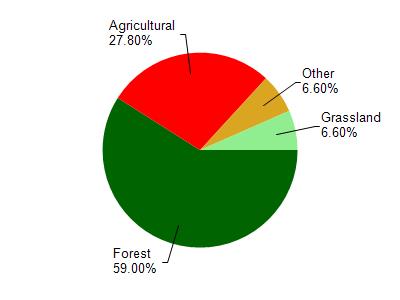Jackson
No
No
Yes
Fish and Aquatic Life
Overview
Trow Lake is a 43 acre impoundment of Halls Creek, located just downstream of Oakwood Lake in the Village of Merrillan. Water quality monitoring in 1992 indicated extremely high chlorophyll and nutruent levels. These nutrient levels contribute to the algal problems seen in the lake (Sorge). The Village of Merrillan discharges their treated wastewater to Trow Lake. This lake is also on the 1998 Wisconsin impaired waters (303(d)) list provided to the United States Environmental Protection Agency due to high pH values. Contributing factors may be the high nutrient levels from both point and nonpoint sources creating excess plant and algae growth which in turn can alter the pH value of a waterbody by their respiration process.
Date 1999
Author Aquatic Biologist
Historical Description
This soft water drainage impoundment has clear (not turbid), alkaline water with a low transparency. The dam has a 17 foot height and is located on Halls Creek. It is owned by the Village of Merrillan. The sport fishery consists of largemouth bass, crappie, bluegill, pumpkinseed and perch. Carp are present and chemical eradication of this species has been considered. There is a boat launching site with parking, a park area, and shoreline access around a portion of the flowage. At the time of the survey, there were 18 dwellings. Migrating diving and puddle ducks use the water and nesting wood ducks may be noted.
Source: 1968, Surface Water Resources of Jackson County Trow Lake (Lower Merrillan Pond), T23N, R4W, Section 26 Surface Acres = 37.1, S.D.F. = 2.63, Maximum Depth = 9.0 feet.
Date 1968
Author Aquatic Biologist
Condition
Wisconsin has over 84,000 miles of streams, 15,000 lakes and milllions of acres of wetlands. Assessing the condition of this vast amount of water is challenging. The state's water monitoring program uses a media-based, cross-program approach to analyze water condition. An updated monitoring strategy (2015-2020) is now available. Compliance with Clean Water Act fishable, swimmable standards are located in the Executive Summary of Water Condition in 2018. See also the 'monitoring and projects' tab.
Reports
Management Goals
Wisconsin's Water Quality Standards provide qualitative and quantitative goals for waters that are protective of Fishable, Swimmable conditions [Learn more]. Waters that do not meet water quality standards are considered impaired and restoration actions are planned and carried out until the water is once again fishable and swimmable
Management goals can include creation or implementation of a Total Maximum Daily Load analysis, a Nine Key Element Plan, or other restoration work, education and outreach and more. If specific recommendations exist for this water, they will be displayed below online.
Monitoring
Monitoring the condition of a river, stream, or lake includes gathering physical, chemical, biological, and habitat data. Comprehensive studies often gather all these parameters in great detail, while lighter assessment events will involve sampling physical, chemical and biological data such as macroinvertebrates. Aquatic macroinvertebrates and fish communities integrate watershed or catchment condition, providing great insight into overall ecosystem health. Chemical and habitat parameters tell researchers more about human induced problems including contaminated runoff, point source dischargers, or habitat issues that foster or limit the potential of aquatic communities to thrive in a given area. Wisconsin's Water Monitoring Strategy was recenty updated.
Grants and Management Projects
Monitoring Projects
| WBIC | Official Waterbody Name | Station ID | Station Name | Earliest Fieldwork Date | Latest Fieldwork Date | View Station | View Data |
|---|
| 1711500 | Trow Lake (L Merrillan Pond) | 10018185 | Trowe Lake -- Access | 5/22/2024 | 7/16/2025 | Map | Data |
| 1711500 | Trow Lake (L Merrillan Pond) | 273014 | Trow Lake - Center | 2/22/1979 | 9/2/2008 | Map | Data |
| 1711500 | Trow Lake (L Merrillan Pond) | 10002986 | Trow Lake | 8/29/2000 | 7/30/2015 | Map | Data |
|

Watershed Characteristics
Trow Lake (L Merrillan Pond) is located in the Halls Creek watershed which is 115.13 mi². Land use in the watershed is primarily forest (59%), agricultural (27.80%) and a mix of grassland (6.60%) and other uses (6.60%). This watershed has 214.37 stream miles, 148.87 lake acres and 7,228.50 wetland acres.
Nonpoint Source Characteristics
This watershed is ranked High for runoff impacts on streams, Not Available for runoff impacts on lakes and Medium for runoff impacts on groundwater and therefore has an overall rank of Medium. This value can be used in ranking the watershed or individual waterbodies for grant funding under state and county programs.However, all waters are affected by diffuse pollutant sources regardless of initial water quality. Applications for specific runoff projects under state or county grant programs may be pursued. For more information, go to surface water program grants.